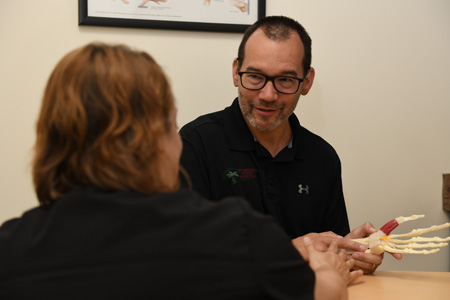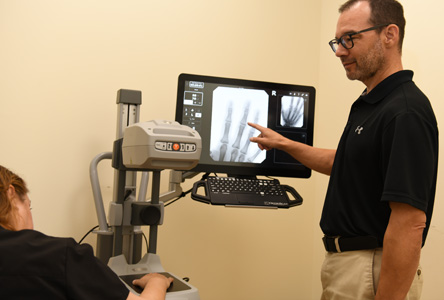Dupuytren's Contracture
![]() Dupuytren’s disease is an abnormal thickening of the tissue just beneath the skin of the palm and fingers known as fascia. Firm cords and lumps may develop that can cause the fingers to bend into the palm, in which case it is described as Dupuytren’s contracture. Although the skin may become involved in the process, the deeper structures, such as the tendons, are not directly involved.
Dupuytren’s disease is an abnormal thickening of the tissue just beneath the skin of the palm and fingers known as fascia. Firm cords and lumps may develop that can cause the fingers to bend into the palm, in which case it is described as Dupuytren’s contracture. Although the skin may become involved in the process, the deeper structures, such as the tendons, are not directly involved.
 Symptoms
Symptoms
Dupuytren's contracture symptoms usually occur very gradually. One or more small, tender lumps or nodules, form in the palm. The lumps are generally firm and adherent to the skin. The nodules may thicken and contract, forming tough cords that extend from the palm into one or more fingers, with the ring and little fingers most commonly affected. These cords may be mistaken for tendons, but they actually occur between the skin and the tendons. These cords cause bending or contractures of the fingers. In many cases, both hands are affected, although the degree of involvement may vary.
The initial nodules may produce discomfort that usually resolves, but Dupuytren’s Contracture is not typically painful. The disease may first be noticed because of difficulty placing the hand flat on an even surface, such as a tabletop. As the fingers are drawn into the palm, you may notice increasing difficulty with activities such as washing, wearing gloves, shaking hands, or putting hands into pockets. Progression is unpredictable. Some individuals will have only small lumps or cords while others will develop severely bent fingers. More severe disease often occurs with an earlier age of onset.
Causes
The cause of Dupuytren’s Contracture is not known, but it may be associated with certain biochemical factors within the involved fascia. It is not caused by an injury or heavy hand use.
There are several factors that put people at risk for developing Dupuytren’s Contracture:
- It is most common in people of Northern European ancestry.
- It often runs in families (hereditary).
- It may be associated with drinking alcohol.
- It is associated with certain medical conditions, such as diabetes and seizures.
- It increases in frequency with age, being more common in men over age 40.
 Treatment Options
Treatment Options
There is no way to stop or cure Dupuytren’s Contracture, and it usually progresses very slowly and may not be troublesome for years. However, it is not dangerous and may never progress beyond lumps in the palm. If the condition does progress, nonsurgical treatment may help to slow it.
The goal of treatment is to improve finger position and thereby hand function. Despite treatment, the disease process may recur. Before treatment, your Celebration Orthopaedics hand surgeon will discuss realistic goals, possible risks and results.
If a lump is painful, an injection of corticosteroid, a powerful anti-inflammatory medication, may help relieve the pain. In some cases, it may prevent the progression of contracture. Several injections may be needed for a lasting effect.
Surgery is recommended when your Celebration Orthopaedics hand surgeon has confirmed through measurements over time that the disease is progressing. Surgery for Dupuytren’s Contracture divides or removes the thickened bands to help restore finger motion. Sometimes the wound is left open and allowed to heal gradually. Skin grafting may be needed to cover open areas if the existing skin is deficient.
Recovery
Some swelling and soreness are expected after surgery, but severe problems are rare. After surgery, elevating your hand above your heart and gently moving your fingers will help relieve pain, swelling, and stiffness.
Physical therapy may be helpful during recovery after surgery. Our Celebration Orthopaedics physical therapists can recommend specific exercises that help strengthen your hands and help you move your fingers. Splinting may also be recommended to maximize and maintain the imporvement of finger position and function.
Most people will be able to move their fingers better after surgery. Approximately 20% of patients experience some degree of recurrence and may require further surgery.
